On the Last and Greatest Day of the Feast
John 7: 37-52
On the last and greatest day of the Feast DIG: Given that every day of the festival of Sukkot water would be poured out as a symbol of thanks for God’s provision, how is Jesus’ statement in Yochanan 7:37-38 especially powerful? Comparing John 7:37-38 with John 4:13-14, what are some ways that the work of the Spirit is like water? Why did Nicodemus risk defending Yeshua? How is the Spirit received? Were the Pharisees correct in Yochanan 7:52? How does the confusion over Messiah’s birthplace cloud the issue of His identity even more? What is there in this passage that glorifies Yeshua as the Word of God?
REFLECT: Has the flow of the Spirit in your life lately felt more like a refreshing spring of a clogged faucet? What have you found helpful in releasing the stream of the Ruach’s water in your life? What is the relationship for you between believing the promises of Christ and experiencing the refreshing power of the Holy Spirit? What different opinions about Messiah do you hear lately? Why does that confusion exist? When have you been ridiculed because of your faith? What did you do?
On the fourteenth of Tishri, the day before the festival of Booths began (to see link click Gn – Conflict at the Feast of Booths), the festive pilgrims had all arrived in Jerusalem. The booths on the rooftops, in the courtyards, in the streets and squares, as well as the roads and gardens, within a Sabbath’s journey, must have given the City of David and neighborhood an unusually picturesque appearance.936 What a scene it must have been to see over two million people camping out.
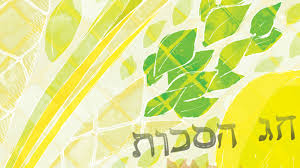
One of the more profound causes of this festive joy was based in the forgiveness of Yom Kippur. The Great Day of Atonement took place five days before Sukkot (Leviticus 23:27 and 34). On Yom Kippur, Israelites had to confess their individual guilt and remorse before ADONAI and rededicate themselves to upholding the mitzvot of the Torah. But after Yom Kippur, Sukkot was the most joyous of all the festivals. The last and greatest day of the festival of Sukkot was called the Great Day or Hosanna Rabba (John 7:37a). Therefore, on last and greatest day of the festival, an additional festival day that the Torah calls The Eighthth Day, was the same day that Yeshua had been dedicated and circumcised (see At – On the Eighth Day, When it was Time to Circumcise Him, He was Named Yeshua).
A Temple ritual that was definitive for the festival of Sukkot during the life of Christ consisted of the Sho’eva procession, meaning the water drawing ritual. To see a short video on this procession click here. There is nothing written about this by Moshe in the Torah; however, this custom was based upon the words of Isaiah the prophet when he wrote: I thank You, ADONAI, because, although You were angry with me, but Your anger is now turned away; and You are comforting me. “See! God is my salvation. I am confident and unafraid; for Yah ADONAI is my strength and my song, and He has become my salvation!” Then you will joyfully draw the water from the springs of salvation. On that day you will say, “Give thanks to ADONAI! Call on His name! Make His deeds known among the peoples, declare how exalted is His name. Sing to ADONAI, for He has triumphed – this is being made known throughout the earth. Shout and sing for joy, you who live in Tziyon; for the Holy One of Isra’el is with you in His greatness” (Isaiah 12:1-5 CJB).
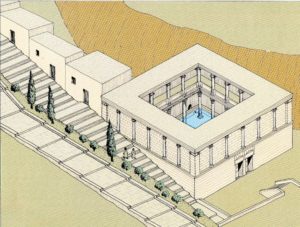
From the Temple to the Pool of Siloam: At the time of the morning burnt offering, a lead priest, accompanied by the jubilant throng of people, took a golden pitcher from the Holy Place in the Sanctuary, through the Nicanor Gate into the Court of the Women, then out into the Court of the Gentiles, and down through the mouth of the southern Double Gate, through the tunnel and down a street with steps to the pool of Siloam, which was located at the southern end of the City right below. To the sound of music the procession wove its way through the crowded Ophel to the very edge of Siloam, down the edge of the Tyropoeon Valley, where it merges with the Kidron Valley. Terraces mark where the gardens that were watered by a living spring, extending from the King’s Gardens by the spring Rogel down to the entrance into the Tyropoeon. Here was the so-called “Fountain Gate,” and the overflow filled the pool called Siloam. When the Sho’eva procession had reached the pool, the lead priest filled his golden pitcher with a little more than two pints of water from the springs of salvation (Isaiah 12:3 CJB).
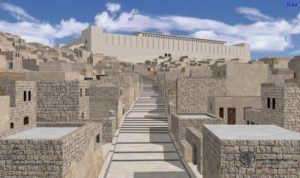
From the Pool of Siloam back to the Temple: Then together with the crowd accompanying him, the process was reversed. The lead priest would guide them back up the same steps to the southwest corner of the Temple Mount. The great multitude came back up through the mouth of the Double Gate into the Court of the Gentiles. Then they would wind their way through the western Huldah Gate, go up stairs to the Chel, turn right past the southern side of the Sanctuary, and around through the Eastern Gate and into the Court of the Women. The men would then proceed up fifteen steps to the Nicanor Gate. These steps were deliberately built as a symbolic description of the fifteen songs of ascent in the book of Psalms. They were songs that were sung by the people, with flute accompaniment, during the three great ascents to Yerushalayim – with the festivals of Pesach, Weeks, and Sukkot in mind (Exodus 23:17). These songs of ascent depicted the happy communion of God’s people in the Temple, with God and each other.937
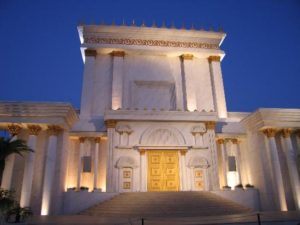
On the first step they would sing Psalm 120, on the second step they would sing Psalm 121, on the third step they would sing Psalm 122, on the fourth step they would sing Psalm 123, all the way through steps one through fifteen and Psalm 120 through Psalm 134. Standing room was limited because millions of Jews that were in the City and the area within the Camp of the Sh’khinah could not accommodate everyone. Countless men were packed in the Court of Isra’el and many women celebrated the pouring of the waters from galleries that were located above their court. These magnificent galleries were exclusively reserved for the women at large gatherings on feast days. In this, the women had an excellent view of the worship activities both in the Court of the Women and also in the Camp of the Sh’khinah.938 But, there were also a great multitude of men and women within the Court of the Women itself.
Inside the Court of the Priests: Once inside the dividing wall of partition (see my commentary on Acts Cn – Paul’s Advise from Jacob and the Elders at Jerusalem) and up the stairs to the Chel, the lead priest, with his golden pitcher of water, separated from the throng of worshipers and entered through the Water Gate, which was one of the three gatehouses (along with the Kindling Gate and the Gate of the Firstlings) in the south innermost court on the side of the Sanctuary. There, another priest who carried the wine for the drink offering joined him. Then the two priests went together and ascended the steps of the bronze altar and turned to the left. They came to two silver funnels, one to the east (which was somewhat wider) and one to the west, with narrow openings leading down to the base of the bronze altar. Wine was poured into the funnel to the east, and at the same time, water was poured into the funnel to the west. After the pouring of the waters, the people would call out to the priest to raise the golden pitcher for the last time that day to see for themselves that the lead priest had poured out every last drop.
During the first six days of the Feast, each morning a different priest would march from the Temple to the Pool of Siloam and back to the bronze altar to pour out the water only once. But, on the seventh day, they made seven trips while reciting the great Hallel. The worshipers sang the Hallel and as the water was poured they shook their palm branches (like the ones that they had used to construct their booths) in triumph. Likewise, during the first six days, a large number of pilgrims marched around Jerusalem only once with music and shouts in remembrance of the taking of Jericho (Joshua 6:21). On the seventh day, however, they made seven trips around Jerusalem while reciting Psalm 118.
The rabbis taught that the outpouring of the waters symbolized the outpouring of the Holy Spirit because the Talmud distinctly says: Why is the name of it called, “The outpouring of the waters?” Because of the pouring out of the Ruach Ha’Kodesh, according to what is said, “With joy shall you draw water out of the springs of salvation.” Therefore, also, the feast and the special joy of it are similar as those of “the drawing out of water.” For according to the rabbinical authorities, the Ruach dwells in man only through joy.939
Immediately after the pouring of the water for the seventh and last time that day, the great Hallel, consisting of Psalms 113 through 118 was chanted responsively to the accompaniment of flutes. As the Levites sang the first line of each Psalm, the people repeated it and then responded with great enthusiasm: Praise to ADONAI. But, when they got to Psalm 118 for that seventh time that day, the people not only repeated the first line of Psalm 118:1: Give thanks to ADONAI, for He is good, but also these: You have become [our] salvation (Psalm 118:21 CJB) and Please ADONAI, Save us! Please, ADONAI, Rescue us (Psalm 118:25 CJB), and again, at the close of the Psalm: Give thanks to ADONAI, for He is good, for His grace continues forever (Psalm 118:29 CJB). As they chanted these lines all the leaves were shaken off the willow boughs that they held in their hands, and the palm branches beaten in pieces, as if to remind God of His promises.940 This is when the zeal of the people reached its highest pitch. The rabbis teach that whoever has not seen the rejoicing of the outpouring of the water had never really experienced joy in their life (BT Sukkah 51a).
Then there was a pause to prepare for the special sacrifice of seven bulls, two rams, fourteen male lambs, and a goat (see the commentary on Numbers Fg – The Hag Sukkot Offering). Since the people had chanted at the top of their lungs for what seemed like an eternity, when they had a chance, they all slumped to the ground, drained of emotion. In that moment of silence, Jesus stood and said in a loud urgent voice, full of conviction, so piercing as to be heard by everyone: Let anyone who is thirsty come to Me and drink. Christ did not interrupt the feast, for it had paused for a moment, but He fulfilled it. Whoever believes in Me, as Scripture has said, rivers of living water will flow from within them (John 7:37b-38).
Don’t we all need regular sips from ADONAI’s reservoir? In countless situations – stressful meetings, loneliness, financial troubles, problems with relationships, screaming children, demanding bosses – many times a day, we can step to the underground spring of God. And there, again and again we can receive redemption for our sin and death, the energy of His Spirit, His lordship and yes – His love. You don’t have to live with a dehydrated soul. You don’t have to be rich, religious, or successful to drink; you simply need to follow the instructions on what – or better, who – to drink. Yeshua. In order for the Lord to do what water does, you must let Him penetrate your heart. Deep, deep inside. Internalize Him. Welcome Him into the inner workings of your life. Drink deeply and often . . . and out of you will flow rivers of living water.941
By this He meant the Spirit, whom those who believed in Him were later to receive. Up to that time the Holy Spirit had not been given, since Jesus had not yet been glorified (John 7:39). The rabbis interpreted this ceremony to symbolize the outpouring of the Ruach Ha’Kodesh in the last days of Isra’el. The Pharisees themselves connected this with the work of the Ruach Ha’Kodesh. In the book of Ruth Rabba IV it states, “And why is it called ‘pouring out?’ Because they poured out the Ruach Ha’Kodesh there, as it is written: And with delight you will draw water from the springs of salvation.” The connection between the drawing of water and the pouring out of the Ruach is most easily seen through the promise of the prophet: For I will pour water on the thirsty Land and streams on the dry ground; I will pour My Ruach on your descendants, My blessing on your offspring (Isaiah 44:3 CJB). While many would come to believe in Him, the Holy Spirit would not permanently indwell believers until the Feast of Weeks (see my commentary on Acts Al – The Ruach Ha’Kodesh Comes at Shavu’ot). Before that, the indwelling of the Ruach was temporary.
When the profoundly moving words of the Lord Jesus Christ were uttered aloud in the Court of the Women, an uproar broke out among the crowd. Messiah’s words forced everyone to come to a decision. Was the Nazarene the promised Messiah or not? On hearing His words, some of the people said: Surely this man is the Prophet (Deut 18:14-22). Others said: He is the Messiah. Still others asked, “How can the Messiah come from Galilee? They didn’t know He was born in Bethlehem because they assumed He was born in Nazareth, and that wasn’t where the Meshiach was supposed to come from. Doesn’t the TaNaKh say that the Messiah will come from David’s descendants and from Bethlehem (Micah 5:2), the town where David lived?” Thus the people were divided because of Jesus. Jesus’s words always divide people into two groups: those who believe in Him and those who do not. The middle ground quickly disappears.942 Some wanted to seize Him, but no one laid a hand on Him (Yochanan 7:41-44). Every attempt to kill Him ended in failure.
The religious authorities had sent the Temple guards to arrest Christ when they heard His teaching. Finally they went back to the Sadducees and the Pharisees, who asked them, “Why didn’t you bring Him in?” They replied, “No one ever spoke the way this man does” (John 7:45-46). They didn’t know what He was saying, but they were very impressed. The bottom line was that they came back empty handed. Messiah’s teaching was different from the constant appeal of the rabbis to mere tradition (see Ei – The Oral Law). Thus, it seemed to everyone that His message came directly from heaven because He taught as one who had authority, and not as the Torah-teachers (Matthew 7:29).
“You mean he has deceived you also?” the Pharisees retorted. In other words, “Why are you so stupid?”“Have any of the rulers or of the Pharisees believed in Him? No! But this mob that knows nothing of the Torah – there is a curse on them” (John 7:47-49). The critical religious authorities, although trained in the Torah, which teaches love, not only despised the people of the Land, but also regarded them as under a curse because of their lack of education.943 In effect, the Pharisees were saying that only common people who didn’t know the TaNaKh would believe in this troublemaking Rabbi. But, the problem with their response was that one of their own Sanhedrin members had begun moving towards faith in the Messiah.
Nicodemus, who had gone to Jesus earlier and who was one of their own number, reminded them that a full and open hearing was demanded before anyone could be condemned (see Lh – The Laws of the Great Sanhedrin Regarding Trials). He said: Does our Torah condemn a man without first hearing Him to find out what He has been doing (John 7:50-51)? Nicodemus was a member of the Great Sanhedrin (see Lg – The Great Sanhedrin), or the ruling council. He was the teacher of a rabbinic academy and belonged to the party of the Pharisees. Earlier he had sought out the Lord alone by night (see Bv – Jesus Teaches Nicodemus). The Master’s teaching of the subject of a new birth had obviously affected his heart. So, here he dared question a serious violation of the Sanhedrin’s very own judicial process.
As a result, Nicodemus’ fellow Pharisees went on the attack. Mocking him, they said: Are you from Galilee, too? Look into it, and you will find that a prophet does not come out of Galilee (John 7:52). Calling a Judean a Galilean was the ultimate insult. In effect, they were saying, “Are you also as stupid as they are?” However, if the truth be known, Hosea, Jonah and Elisha were all from Galilee. But because there were no rabbinic schools in Galilee, the rabbis believed that all Galileans were uneducated. The famous Rabbi Hillel once said that ordinary, unlearned people could never be religious.
Jerusalem was a lion’s den for Jesus. He entered it willingly, then deftly moved between the security of seclusion and the safety of the public arena while relying on His Father to close the angry jaws of His enemies. His time had not yet come (John 7:6a KJB) and was still months away. There was work to be done in the meantime – much of it in Judea.944


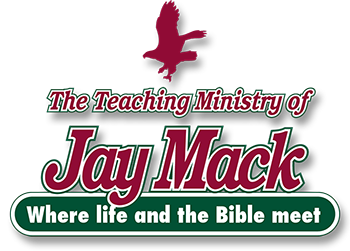
Thank you all for expounding on the scriptures, bringing clear understanding through history, language etc. to us all. Many of us do not have the resources, time or mental capacity to do what God has allowed you to do. Blessings to you ALL!